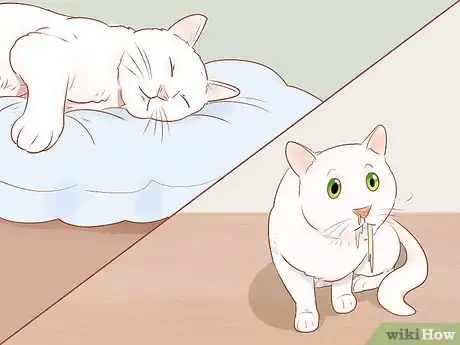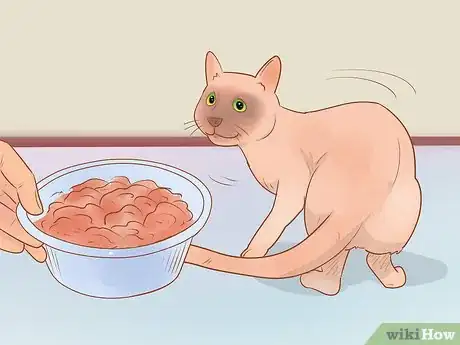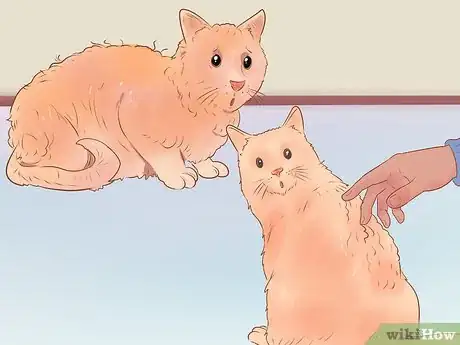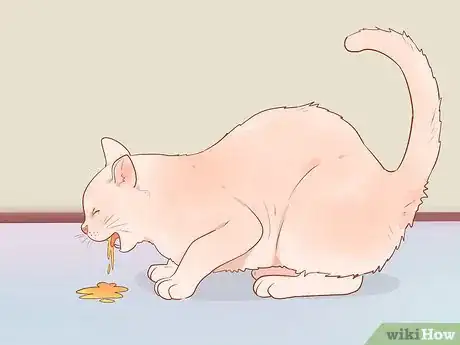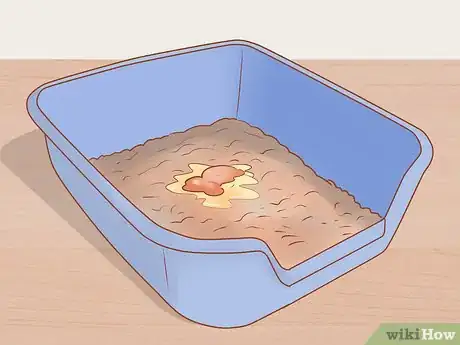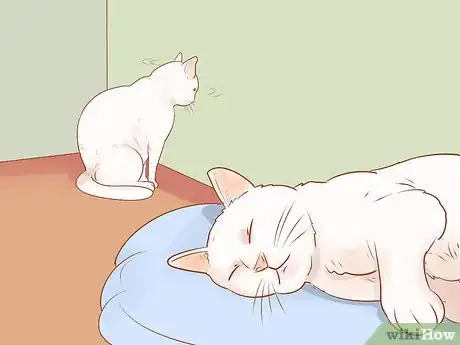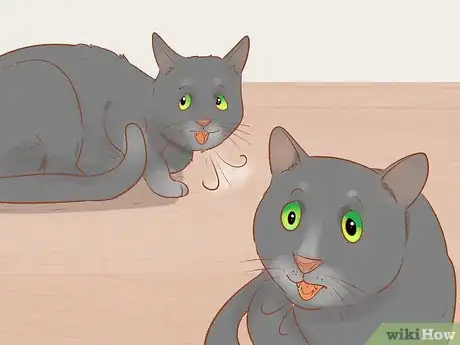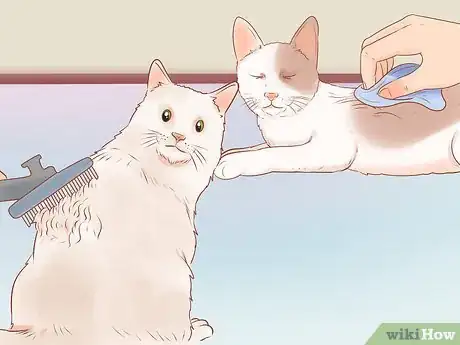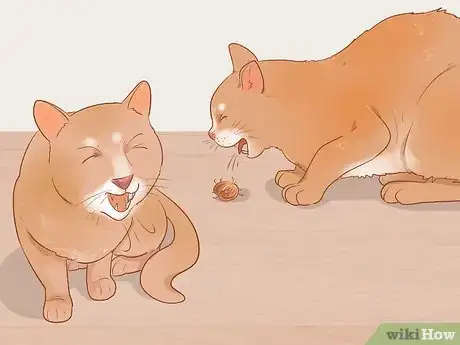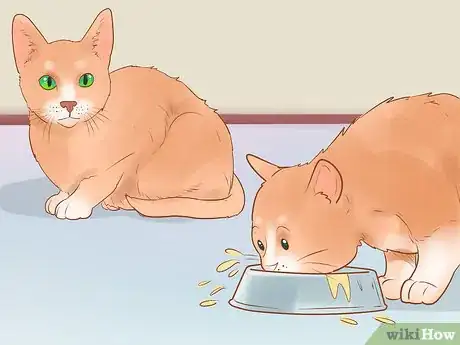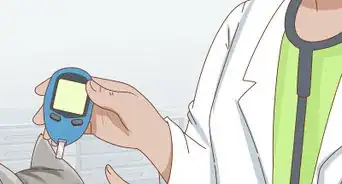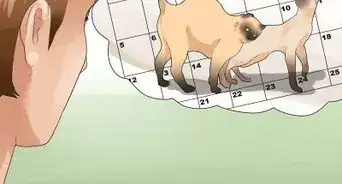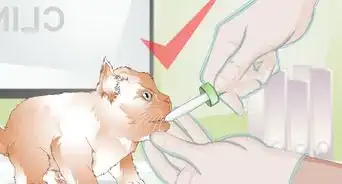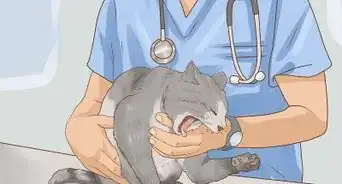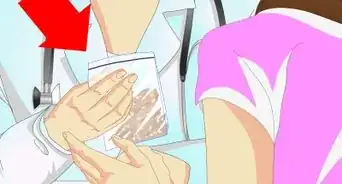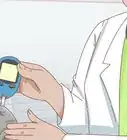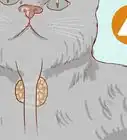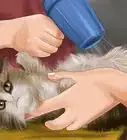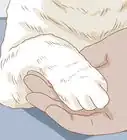This article was co-authored by Pippa Elliott, MRCVS. Dr. Elliott, BVMS, MRCVS is a veterinarian with over 30 years of experience in veterinary surgery and companion animal practice. She graduated from the University of Glasgow in 1987 with a degree in veterinary medicine and surgery. She has worked at the same animal clinic in her hometown for over 20 years.
There are 10 references cited in this article, which can be found at the bottom of the page.
wikiHow marks an article as reader-approved once it receives enough positive feedback. This article received 43 testimonials and 82% of readers who voted found it helpful, earning it our reader-approved status.
This article has been viewed 1,411,218 times.
One of the joys of caring for cats is their laid-back nature. Cats excel at being relaxed and living the sort of lifestyle we can only dream of: playing, eating, and sleeping. Unfortunately, these habits can be a disadvantage if cats become ill. Instinctively, cats may then try to hide away, or else a regular habit (sleeping) becomes exaggerated. To decide whether your cat is actually sick, it helps to know what signs to look for.
Steps
Looking for Changes in Behavior and Appearance
-
1Pay attention to how much your cat sleeps. Sick cats will sleep more. If your cat doesn't have other signs of illness, such as vomiting, diarrhea, loss of appetite, or obvious swellings, then keep him/her under observation. If symptoms develop, get him/her checked by a vet.
- If your cat isn't showing other symptoms, monitor him/her for 24 hours (of course, it's fine to get her checked by a vet before this if you are worried). If he/she enters a second day of excessive tiredness then it's time to take him/her to the vet clinic.[1]
-
2Check your cat's temperature for fever. Use a rectal thermometer to check your cat's temperature. However, if she gets distressed it is best to stop and leave this to your veterinarian. 99.5 to 102.5 °F (37.5 to 39.2 °C) is a normal temperature range, while anything over 102.5 is regarded as raised, and over 103 is feverish.Take your cat to the vet if it has a fever.[2]
- A feverish cat usually sleeps heavily, may refuse food, and often has a dull coat that sticks out at odd angles. Its nose and ears may be dry and warm when you touch them with fingers at normal body temperature. While touching the ears is an inaccurate way of checking temperature, if the cat's ears feel cool then it is unlikely he/she has a fever.
Advertisement -
3Monitor any change in your cat's litter box habits. Pay attention to: how often your cat uses the tray, if it has difficulty, if blood or mucus is in the urine, or if the feces are hard and nugget-like.[3] If the cat has had diarrhea, but continues to strain or has constipation (signaled by the hard dry feces) take it to the vet. Repeated straining and not passing urine, or the presence of blood, should trigger an urgent call to the vet.[4]
- Male cats are prone to urinary problems where they have difficulty passing water. The signs include visiting the tray frequently, and perhaps even squatting outside the tray. The cat may squat for several minutes or keep getting up and moving to a new spot then squatting again. If possible, check to see if he/she produced any urine (is the patch wet or dry?) and if he/she did, check for blood.[5]
-
4Pay attention to your cat’s appetite. If you have noticed that your cat has not been eating much, or has been eating more than normal, there may be something wrong. If your cat shows no interest in food for a full day, there could be a range of issues--from eating the neighbors’ food, to feeling nauseous, to kidney problems. On the other hand, if you cat is suddenly ravenous, it could signal a health issue.
-
5Check to see if your cat is dehydrated. Be alert for changes in your cat's drinking behavior. How much your cat drinks depends on whether he/she eats wet food (in which case it is unusual to see him/her drinking) or dry food (it is normal to see him/her drinking). Many conditions cause increased thirst, such as some types of infections, kidney disease, overactive thyroids, and diabetes. If your cat is thirsty, have him/her checked out by a vet.[8]
- You can also physically check. Carefully and gently, grasp his/her skin between his/her shoulder blades. Pull the skin up and away from his/her body (again, very gently) and then let go. If your cat’s skin does not snap immediately back into place, he/she is more than likely dehydrated and should be taken to the vet.
-
6Pay attention to your cat’s weight and body silhouette. Any change in weight is significant and should merit a trip to the vet. Sudden or even gradual weight loss could signal illness. If in doubt, weigh your cat once a week at home and if the cat keeps losing weight seek veterinary advice.[9]
- In the early stages of conditions such as diabetes or hyperthyroidism, the cat may seem otherwise well, but lose weight. Seek medical advice if the cat keeps losing weight.
- Some illnesses, such as cancer in the belly or heart disease, mean the cat's overall weight stays the same but he/she loses body condition. This means you can feel his/her ribs and backbone more easily as there is less fat cover, but his/her belly might look rounded or swollen. If in doubt, get him/her checked by a veterinarian.[10]
-
7Examine your cat’s coat. A sick cat usually doesn't have the energy to groom himself.Typically, a coat that was once glossy and well-kept becomes dull, matted, and tangled. While stress can account for shedding or changes in grooming habits, your cat may actually be sick. Consult with a vet.[11] [12]
- Changes in grooming habits may also be a result of arthritis. Grooming may be painful if your cat is stiff and sore. Once again, it's a sign that a trip to the vet is necessary.
Looking for Symptoms
-
1Watch for vomiting. If your cat vomits, especially several times a day, and seems under the weather, then this is significant. If the cat either refuses water or vomits after drinking water, then he/she should be seen by a vet.[13]
- Many cats are happy vomiters, meaning they throw up from time to time (once or twice a week) as a means of cleansing their system. This is nothing to worry about in a cat that's active, responsive, behaving normally and eating well.[14]
-
2Look for diarrhea. A cat should produce formed, sausage-like feces. Diarrhea is liquid feces that have no shape, and is definitely abnormal. If the cat is otherwise well, it is acceptable to wait 24 hours to see if the cat has merely eaten something that has upset his/her tummy. However, if he/she is vomiting, off his/her food, listless, or lethargic, or has blood or mucus (a jelly like substance) in her stools, then she should be seen by a vet.[15]
-
3Pay attention to the cat's activity level. Lethargy, or lack of energy, can indicate fever, breathing difficulties, or the cat being in pain. This is subtly different from the cat sleeping more, because the cat is awake, but doesn't have the energy to interact or participate in daily activities. If the cat is lethargic and breathing quicker, he/she should see a vet.[16]
- Take note of your cat’s personality. If your cat is unusually tired and loses interest in exercise and regular daily activities, this could be a sign that your pet is undernourished or ill.
-
4Listen for respiratory problems. If your cat is breathing very quickly and shallowly or with his/her mouth open, and has not been exerting him/herself, you should take your cat to the vet. You should also try to gauge how labored the cat's breathing appears. If you notice his/her stomach muscles heaving, in order to breathe, see the vet.[17]
- Sometimes purring can confuse the respiratory rate (it makes the rate appear faster), so try to count her breaths when he/she is not purring or asleep. The normal respiratory rate in the cat is about 20 - 30 breaths a minute, and should be at the lower end when relaxed.
-
5Pay attention to head tilting, dizziness, or disorientation. All of these may be symptoms of a neurological disorder or ear infection. If present, your cat should be brought to the vet immediately. Your cat is an agile creature who is nimble on his/her feet. If this changes and he/she becomes clumsy, or holds his/her head on one side, then the chances are something is wrong. These changes could signal a stroke, high blood pressure, or even a brain tumor, so a trip to the vet is advisable.[18]
-
6Groom your cat often to check for new lumps or growths. Most lumps or abscesses are benign, but if there is oozing or tenderness it will need to be checked. Also, pay attention to bad smells that can come from infected scratches. Again, get your cat checked. If left untreated, the infection can cause blood poisoning.[19]
-
7Pay attention to your cat's eyes. Examine the eyes (as well as the nose) for any excessive discharge. If your cat constantly appears to be crying, she may be allergic to something or have a sinus infection. If discharge is present with excessive drinking/urination, lethargy, and a lackluster coat have your cat checked by a veterinarian for possible kidney failure.
- Also check pupil dilation. Some illnesses cause cats’ eyes to dilate and remain that way. You should take your cat to the vet immediately if you notice that your cat’s pupils remain very dilated.
-
8Look in your cat's mouth. Specifically, look for any discoloration in the gums. If you notice that your cat’s gums, particularly those with black gums, have become very pale, then your cat might be sick. You should also smell your cat's breath. If there is an odd smell that is not caused by something you are feeding your cat, then there may be a problem.[20]
Checking for a Specific Illness
-
1Check your cat for fleas. Watch for excessive scratching, which may be indicative of fleas. If you see your cat scratching himself often, you will need to perform a spot check. Get a fine toothed comb and run it through your cat’s fur. Look for little, fast-moving brown specks (which are fleas) particularly around your cat’s neck and tail.[21]
- You can also check for fleas by grooming the cat over a sheet of blank white paper. You may see fleas in the comb's teeth or flea dirt on the paper. Flea dirt is black and comma shaped. If placed on damp cotton wool it dissolves into bloody streaks.
- Many commercial products are available to kill fleas and remove them from your home. Ask your vet for specific recommendations.
-
2Listen for dry coughing and vomiting that may signify hairballs. Hairballs can also cause bad breath or low appetite. Serious hairball problems may become Trichobezoars (hard lumps of matted hair and undigested foul-smelling food) and extreme cases may require surgery. Regularly groom your cat to reduce hairballs.[22]
- Other effective home remedies include adding supplements to their diet such as: Slippery Elm Bark to lubricate the hairball passage or pumpkin pulp (canned) which adds bulk fiber to stools, easing the hairball out. These items can periodically be added to treats like fish or cooked chicken/livers as a preventative for hairballs.
- You should consult with the veterinarian to be certain that a more serious problem is not the cause.
-
3Look for hyperthyroidism, or an overactive thyroid. Symptoms include increased appetite or thirst, unexplained weight loss (particularly muscle mass), nervousness or irritability, frequent vomiting, lethargy and weakness, diarrhea, or a messy coat. If two or more symptoms are present, your cat will need to see the veterinarian.[23] Hyperthyroidism typically occurs in middle-aged to older cats and is rare in a young cat.
- Increased appetite is a handy warning sign that your cat needs veterinary attention. The thyroid hormone that triggers appetite also raises the metabolic rate and puts organ function under strain.[24]
-
4Watch for symptoms of feline diabetes. Signs of diabetes include vomiting, dehydration, weakness and loss of appetite, increased thirst and urination, weight loss, breathing abnormalities, and an unkempt coat. Feline diabetes affect cats of any age, but is most common in older, obese male/female cats. If your cat has any or several symptoms, take him/her to the vet where blood and urine sugar levels can be tested.[25]
-
5Watch for symptoms of feline lower urinary tract disease (FLUTD). Signs of FLUTD include inappropriate or difficult and frequent urination, appetite loss, listlessness, blood in the urine, or frequent licking of the genitals. This disease is a painful inflammation of the lower urinary tract that has the potential to quickly become fatal.
- FLUTD has a number of causes, from decreased water intake and urine retention to viruses, bacteria, or diet. Some dry foods can cause crystals to build up in the urine which scuff and irritate the bladder lining. If left untreated, they can form bladder stones which are potentially serious if they cause a blockage.
How Do You Cure a Cat of Constipation?
Expert Q&A
Did you know you can get expert answers for this article?
Unlock expert answers by supporting wikiHow
-
QuestionWhat would cause my cat to lose his voice?
 Pippa Elliott, MRCVSDr. Elliott, BVMS, MRCVS is a veterinarian with over 30 years of experience in veterinary surgery and companion animal practice. She graduated from the University of Glasgow in 1987 with a degree in veterinary medicine and surgery. She has worked at the same animal clinic in her hometown for over 20 years.
Pippa Elliott, MRCVSDr. Elliott, BVMS, MRCVS is a veterinarian with over 30 years of experience in veterinary surgery and companion animal practice. She graduated from the University of Glasgow in 1987 with a degree in veterinary medicine and surgery. She has worked at the same animal clinic in her hometown for over 20 years.
Veterinarian
-
QuestionWhy is my cat lifting up her rear end and making strange noises?
 Pippa Elliott, MRCVSDr. Elliott, BVMS, MRCVS is a veterinarian with over 30 years of experience in veterinary surgery and companion animal practice. She graduated from the University of Glasgow in 1987 with a degree in veterinary medicine and surgery. She has worked at the same animal clinic in her hometown for over 20 years.
Pippa Elliott, MRCVSDr. Elliott, BVMS, MRCVS is a veterinarian with over 30 years of experience in veterinary surgery and companion animal practice. She graduated from the University of Glasgow in 1987 with a degree in veterinary medicine and surgery. She has worked at the same animal clinic in her hometown for over 20 years.
Veterinarian
-
QuestionWhat is best for fleas?
 Pippa Elliott, MRCVSDr. Elliott, BVMS, MRCVS is a veterinarian with over 30 years of experience in veterinary surgery and companion animal practice. She graduated from the University of Glasgow in 1987 with a degree in veterinary medicine and surgery. She has worked at the same animal clinic in her hometown for over 20 years.
Pippa Elliott, MRCVSDr. Elliott, BVMS, MRCVS is a veterinarian with over 30 years of experience in veterinary surgery and companion animal practice. She graduated from the University of Glasgow in 1987 with a degree in veterinary medicine and surgery. She has worked at the same animal clinic in her hometown for over 20 years.
Veterinarian There are lots of different flea products on the market to choose from so it can seem confusing. Products containing fipronil or selamectin as the active ingredient have been widely tested as safe for cats and deadly for fleas so these are good to use. Be very careful only to use a product marked for use in cats, as many of the dog products are toxic to our feline friends.
There are lots of different flea products on the market to choose from so it can seem confusing. Products containing fipronil or selamectin as the active ingredient have been widely tested as safe for cats and deadly for fleas so these are good to use. Be very careful only to use a product marked for use in cats, as many of the dog products are toxic to our feline friends.
Warnings
- If your cat does not eat or drink anything for two days, bring them to the vet immediately for an examination.⧼thumbs_response⧽
- If your cat is dehydrated and vomiting, it is important to get to a vet immediately, as this can lead to total renal shutdown or failure, which is fatal.⧼thumbs_response⧽
- If your cat has lost complete control of their bodily functions, then it needs to get to a vet immediately. If they don't, then this can also lead to kidney failure, which can potentially be fatal in cats.⧼thumbs_response⧽
- Humans are also susceptible to itchy flea bites, usually on the ankles.⧼thumbs_response⧽
- Kittens may become anemic if exposed to fleas.⧼thumbs_response⧽
- The most common flea, the cat flea (Ctenocephalides Felis) may carry Dipylidium Caninum tapeworm larvae. If cats eat fleas while grooming, they may become infested. Fleas also transmit other infectious agents.⧼thumbs_response⧽
- If your cat is sick, please consult your vet before giving it any medicine, including home remedies or supplements.⧼thumbs_response⧽
References
- ↑ BSAVA Manual of Textbook of Veterinary Nursing. Cooper & Moulineaux. BSAVA publications.
- ↑ BSAVA Manual of Textbook of Veterinary Nursing. Cooper & Moulineaux. BSAVA publications.
- ↑ http://www.petfinder.com/cats/cat-health/subtle-signs-of-a-sick-cat/
- ↑ Small Animal Internal Medicine. Nelson & Couto. Publisher: Mosby. 5th edition
- ↑ Small Animal Internal Medicine. Nelson & Couto. Publisher: Mosby. 5th edition
- ↑ http://www.petfinder.com/cats/cat-health/subtle-signs-of-a-sick-cat/
- ↑ Consultations in Feline Internal Medicine. August. Publisher. Saunders.
- ↑ Small Animal Internal Medicine. Nelson & Couto. Publisher: Mosby. 5th edition
- ↑ Small Animal Internal Medicine. Nelson & Couto. Publisher: Mosby. 5th edition
- ↑ Small Animal Internal Medicine. Nelson & Couto. Publisher: Mosby. 5th edition
- ↑ http://www.readersdigest.ca/pets/care/6-ways-tell-if-your-cat-is-sick
- ↑ BSAVA Manual of Textbook of Veterinary Nursing. Cooper & Moulineaux. BSAVA publications.
- ↑ Small Animal Internal Medicine. Nelson & Couto. Publisher: Mosby. 5th edition
- ↑ Small Animal Internal Medicine. Nelson & Couto. Publisher: Mosby. 5th edition
- ↑ Small Animal Internal Medicine. Nelson & Couto. Publisher: Mosby. 5th edition
- ↑ Small Animal Internal Medicine. Nelson & Couto. Publisher: Mosby. 5th edition
- ↑ Small Animal Internal Medicine. Nelson & Couto. Publisher: Mosby. 5th edition
- ↑ Consultations in Feline Internal Medicine. August. Publisher. Saunders.
- ↑ BSAVA Manual of Textbook of Veterinary Nursing. Cooper & Moulineaux. BSAVA publications.
- ↑ http://www.readersdigest.ca/pets/care/6-ways-tell-if-your-cat-is-sick
- ↑ http://www.aspca.org/pet-care/cat-care/fleas
- ↑ http://pets.webmd.com/cats/guide/what-to-do-about-hairballs-in-cats
- ↑ http://www.aspca.org/pet-care/cat-care/hyperthyroidism
- ↑ Consultations in Feline Internal Medicine. August. Publisher. Saunders.
- ↑ http://www.vcahospitals.com/main/canine-feline-diabetes-awareness/feline-diabetes-awareness
About This Article
To know if your cat is sick, watch for symptoms like frequent diarrhea and vomiting, which could be a sign that something is wrong. Also, listen to your cat's breathing. If it’s breathing very quickly and shallowly with its mouth open, it may be sick. You should also look at your cat’s eyes and nose for excessive discharge, which can be signs of allergies or illness. These, along with changes in your cat’s sleeping and eating patterns, probably mean it’s time for a visit to the vet. For more from our Veterinary reviewer on whether your cat is sick, including how to check for feline diabetes and other illnesses, read on!
